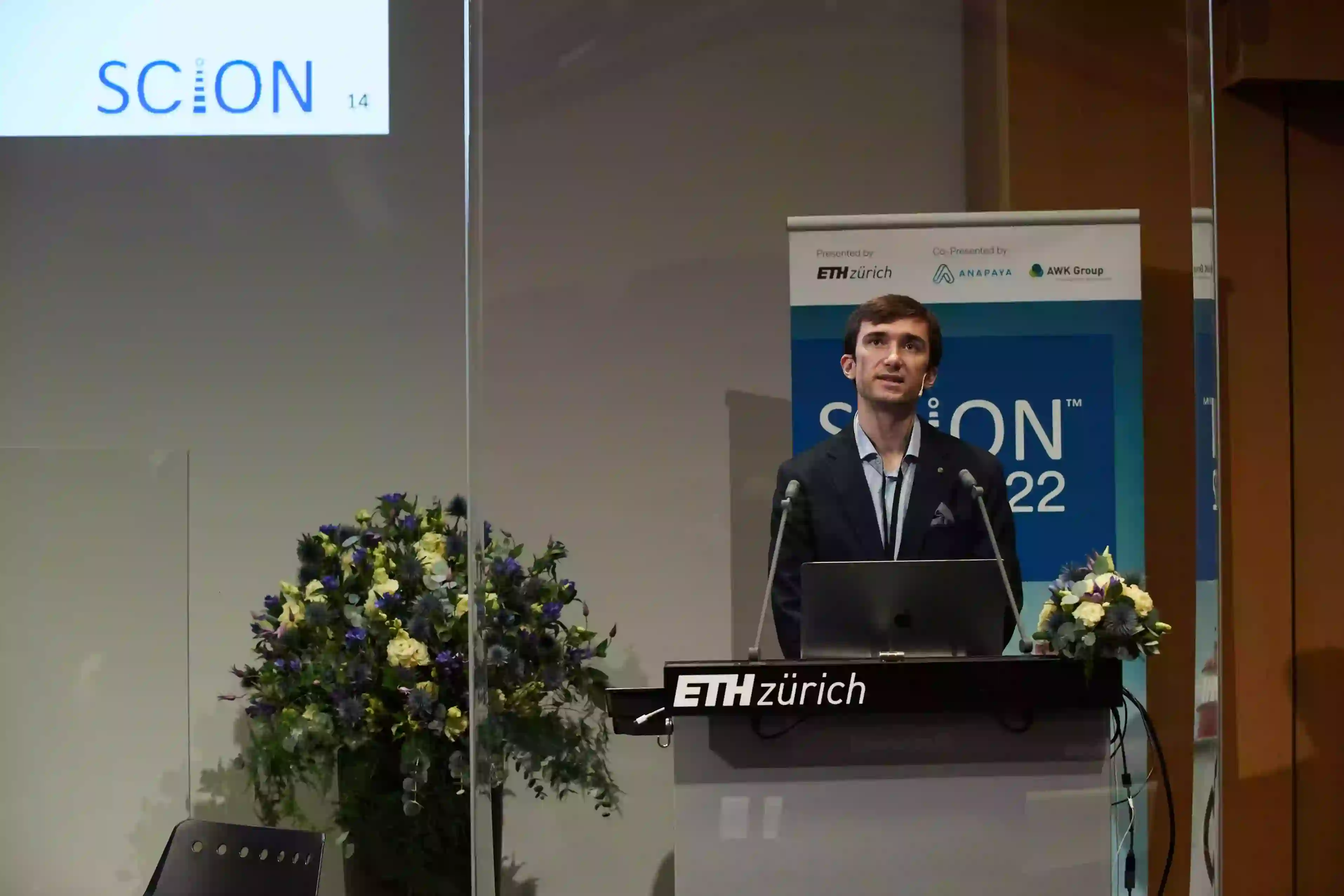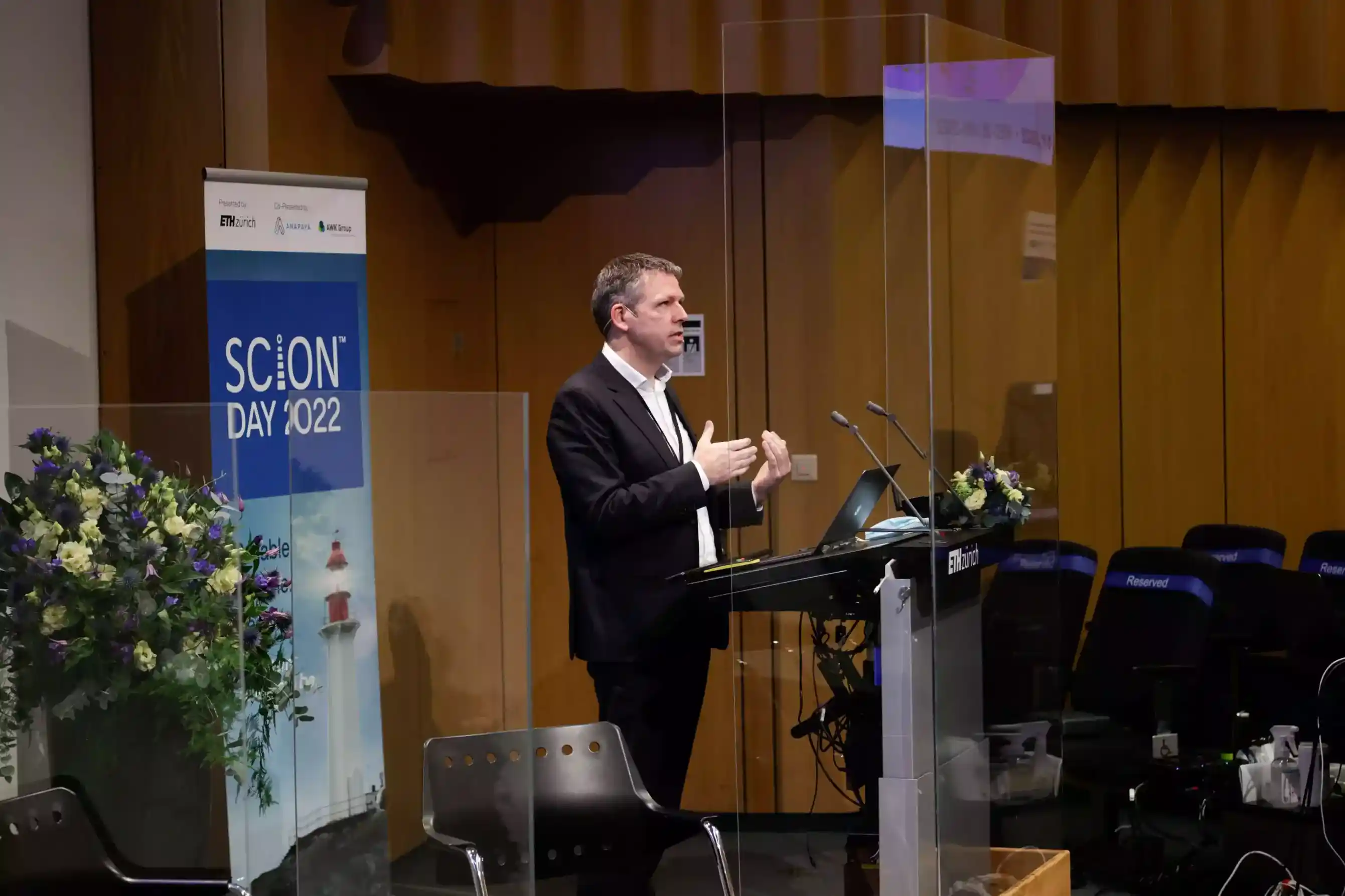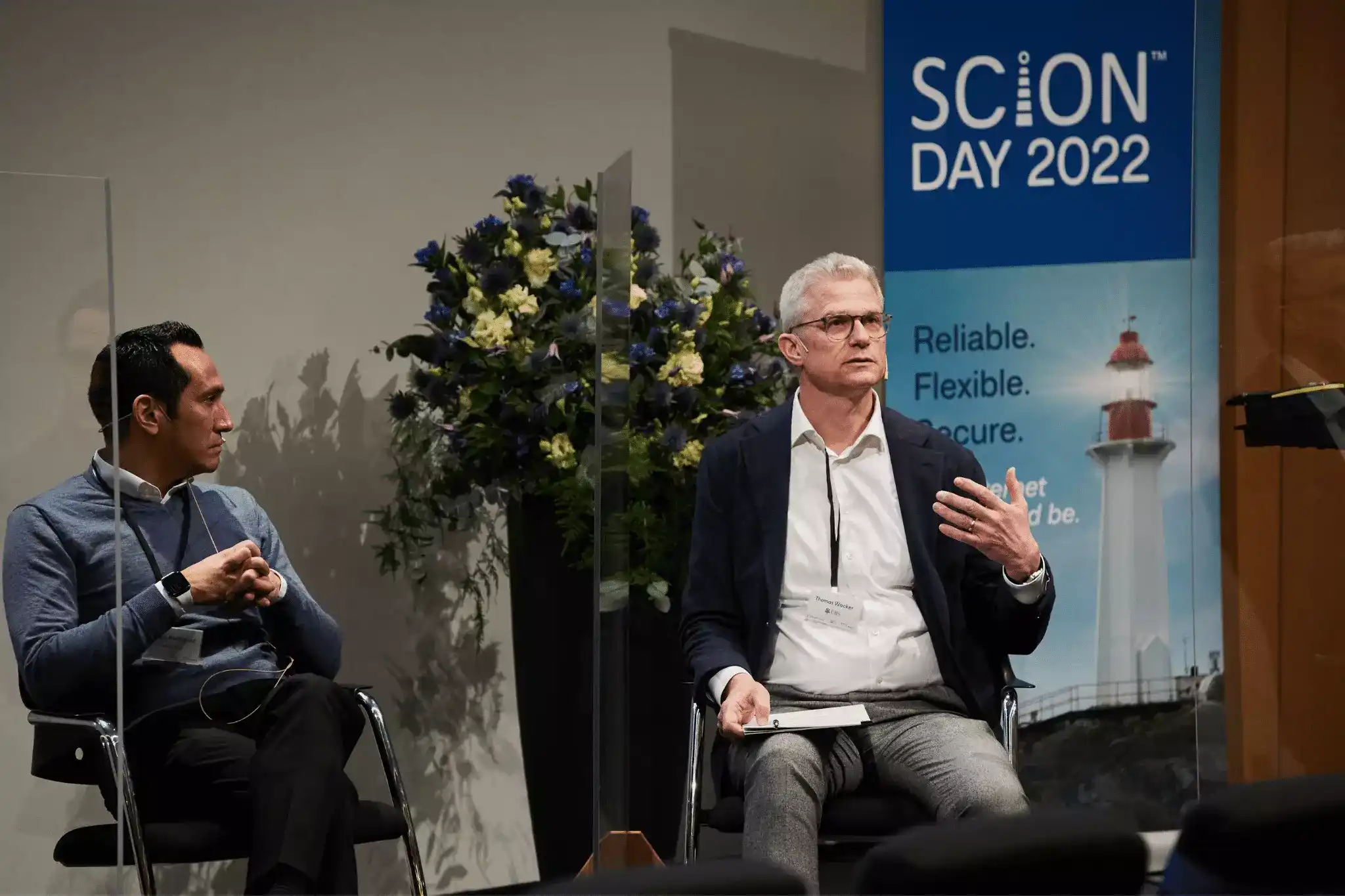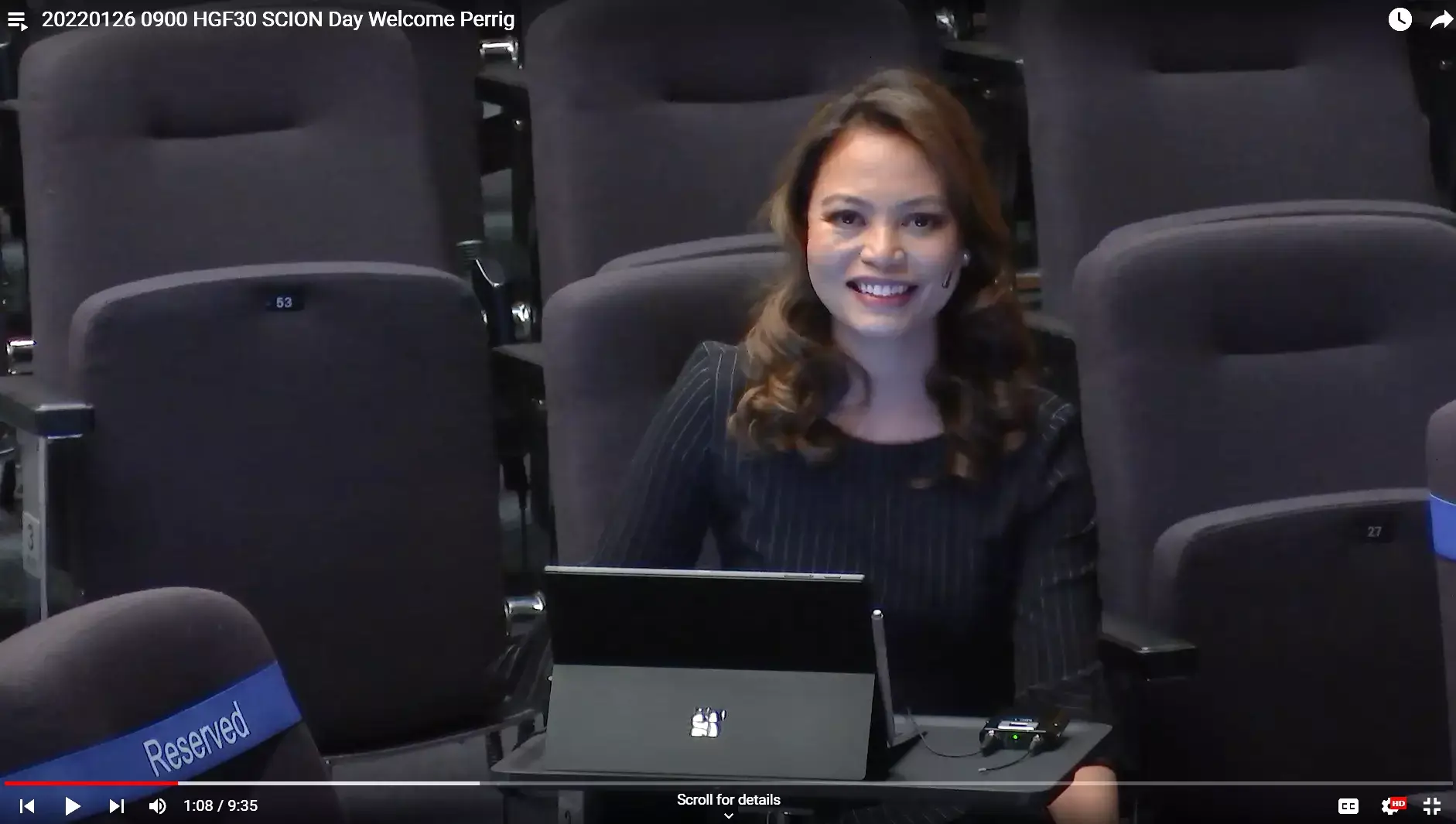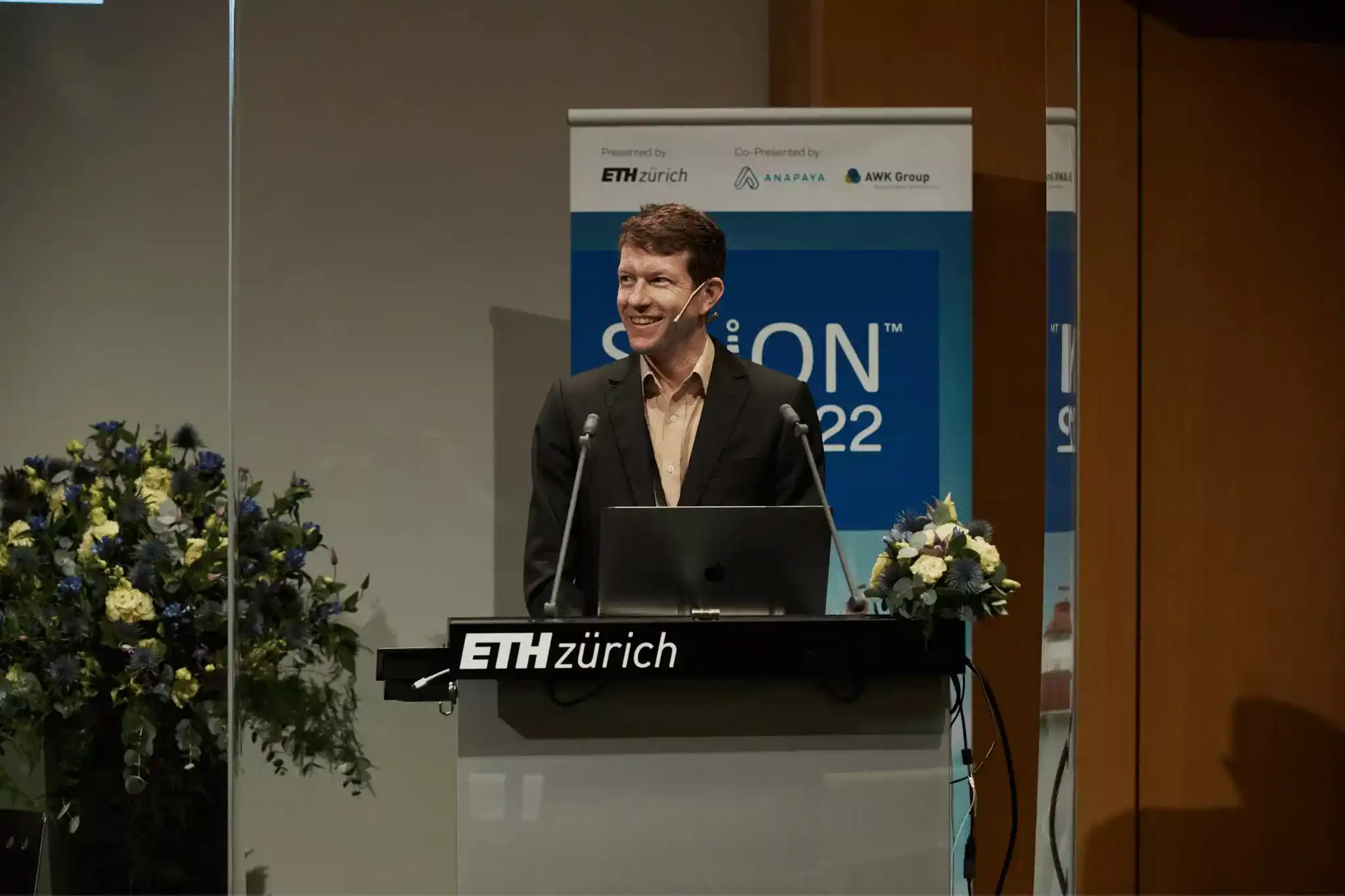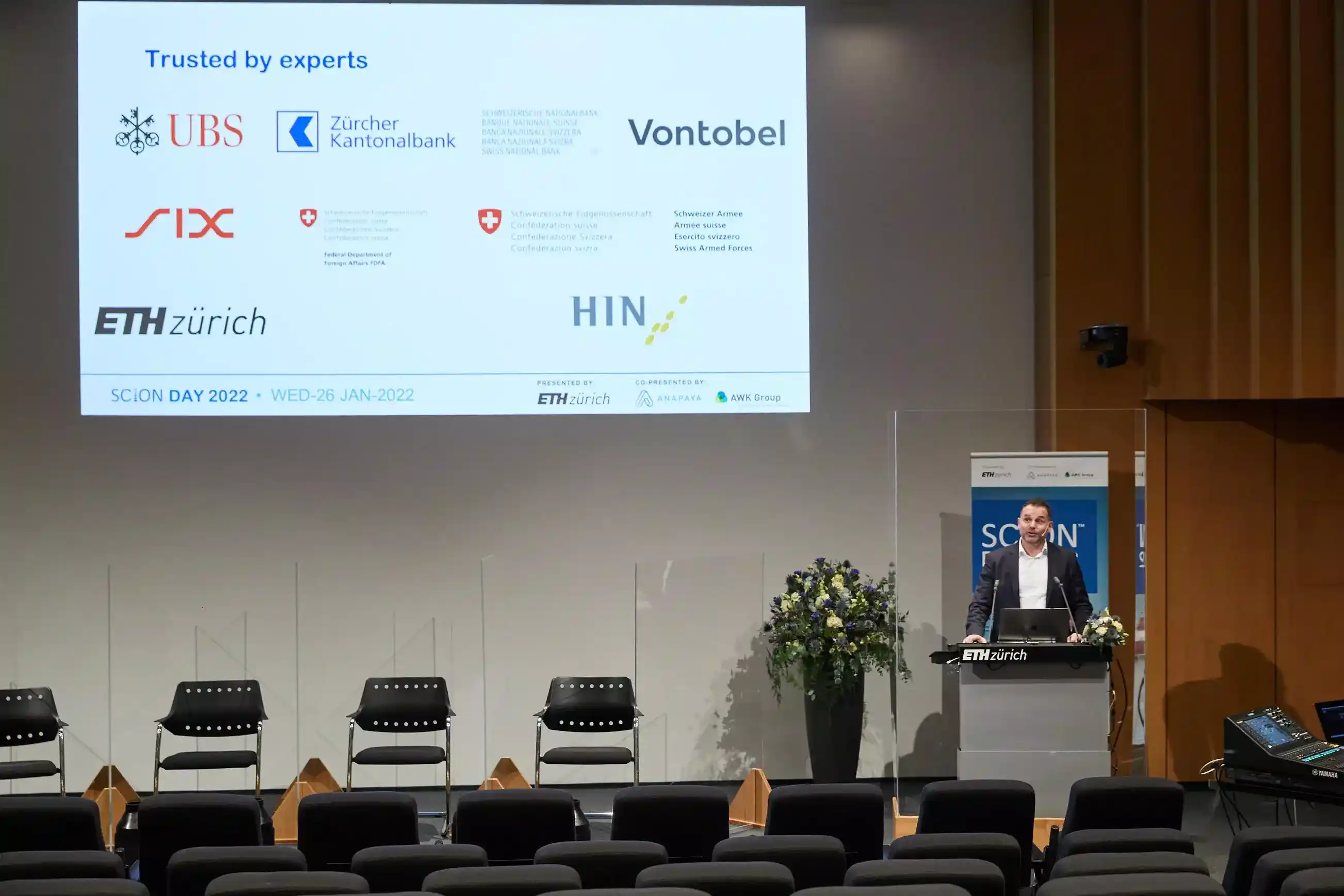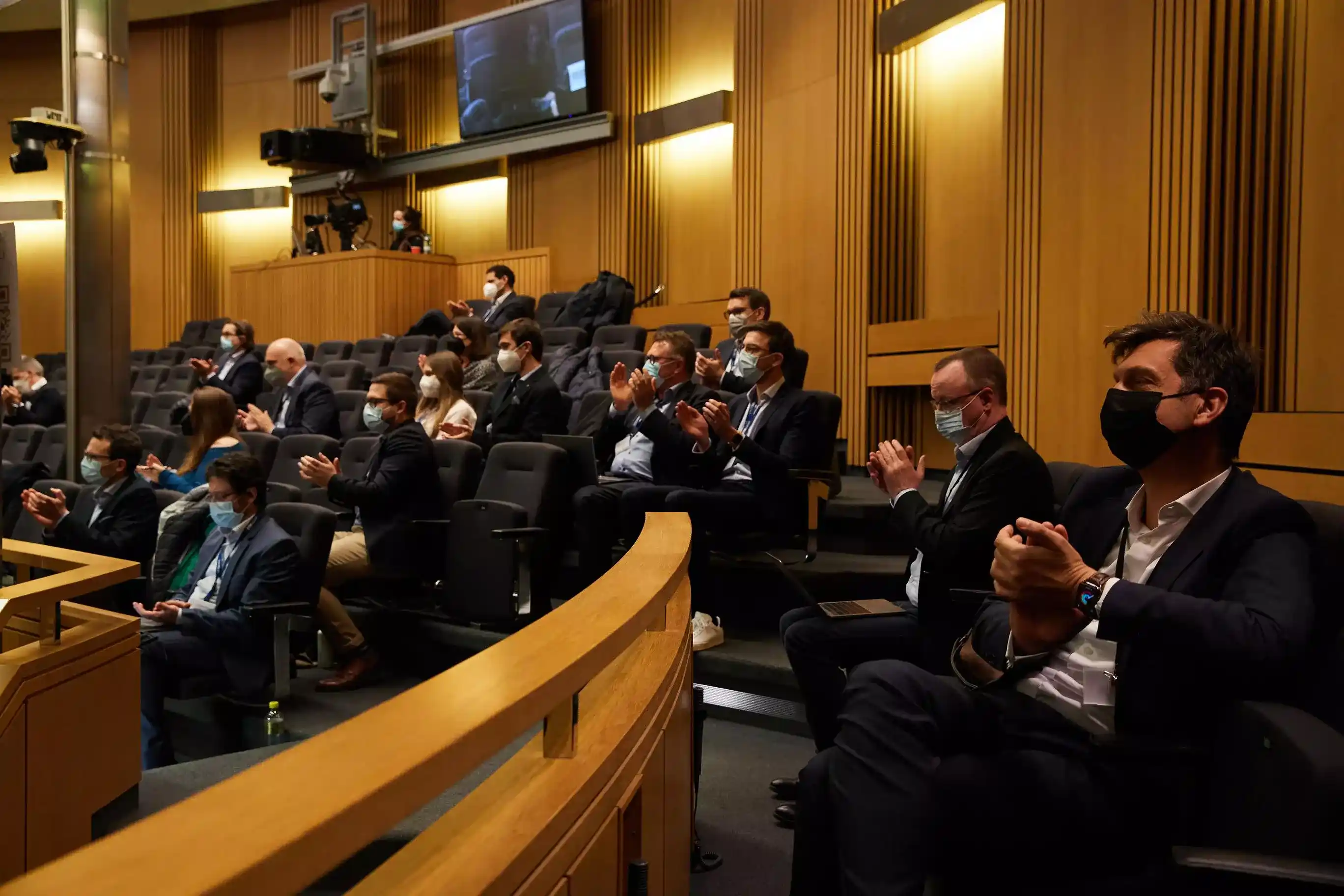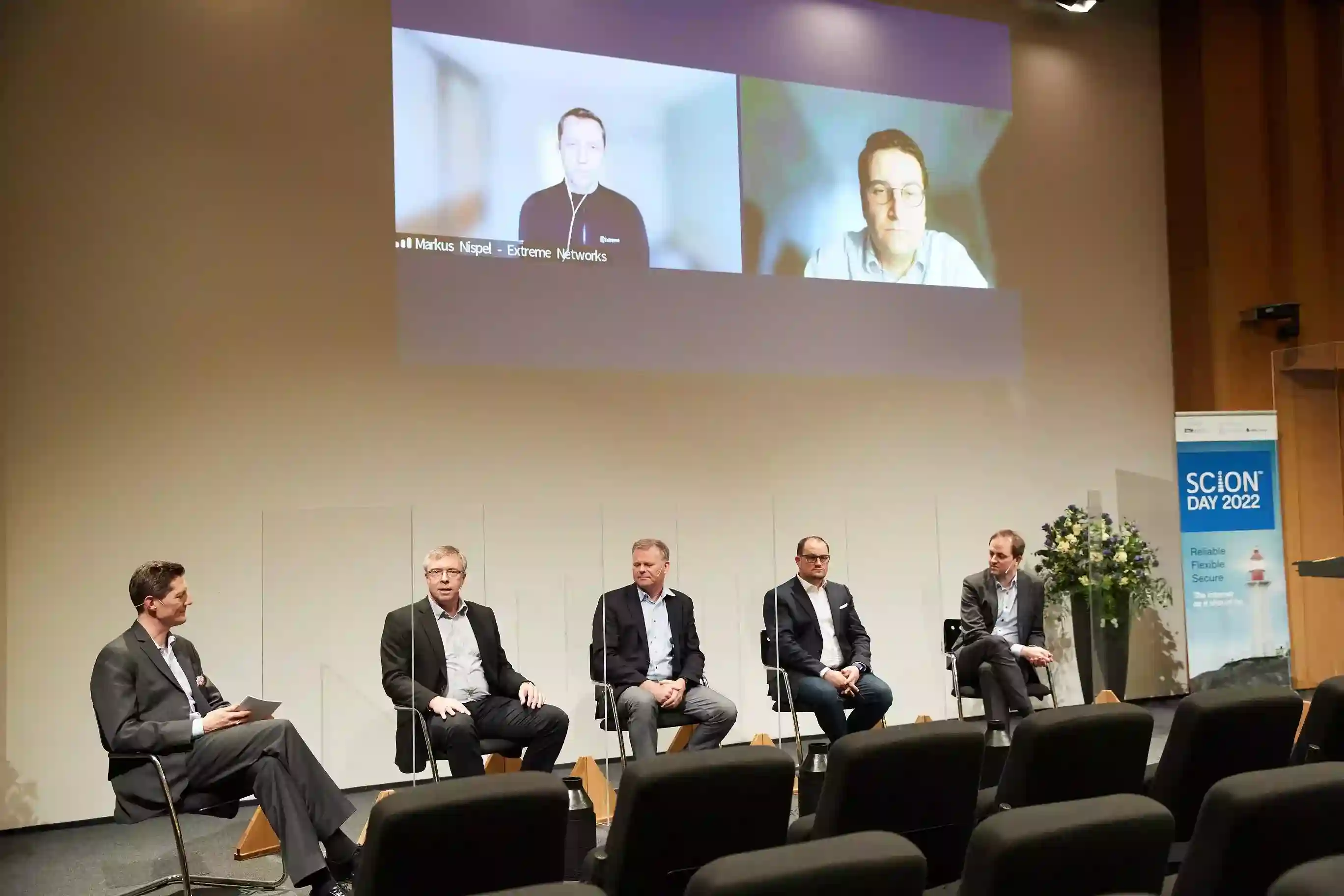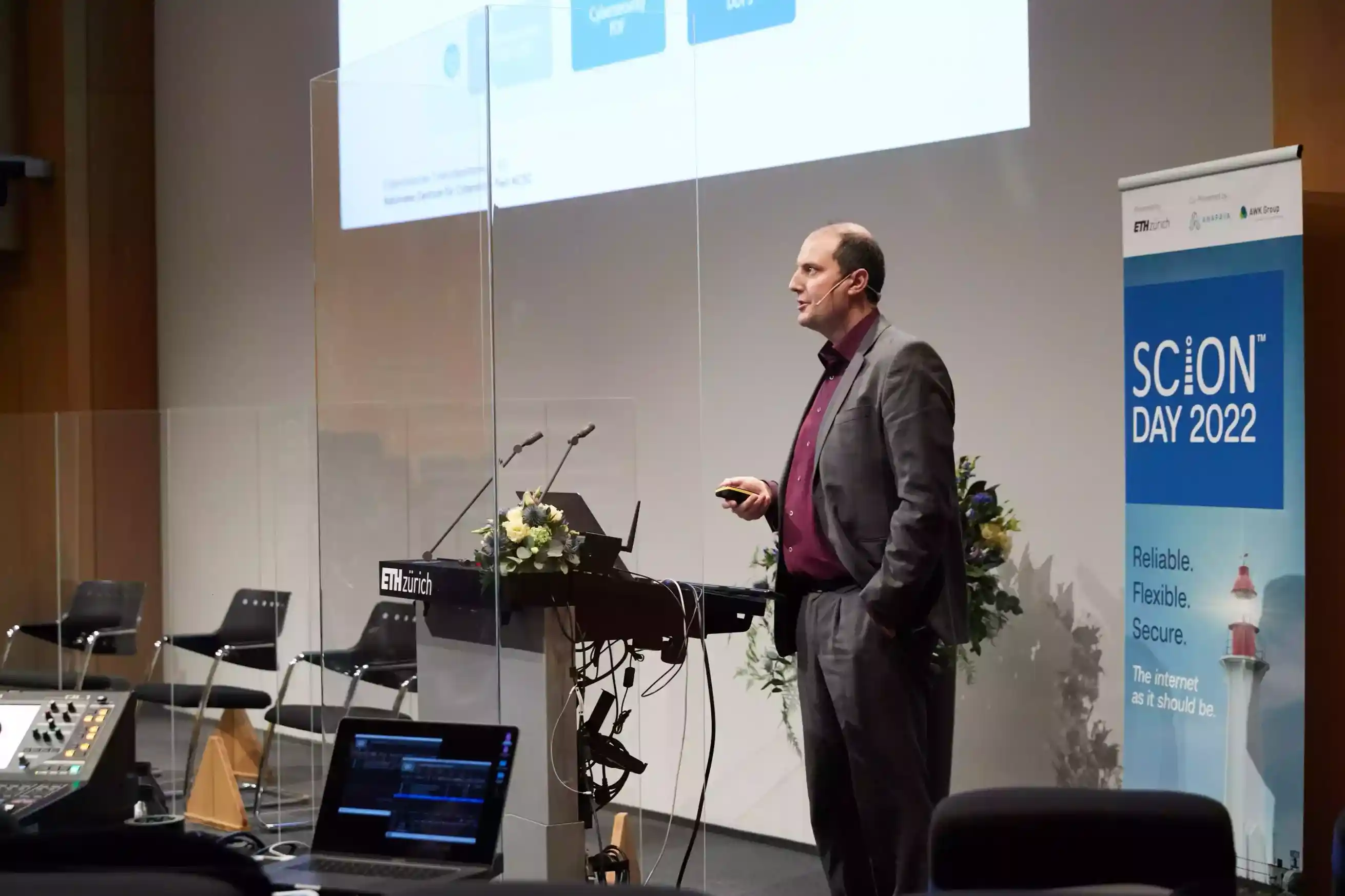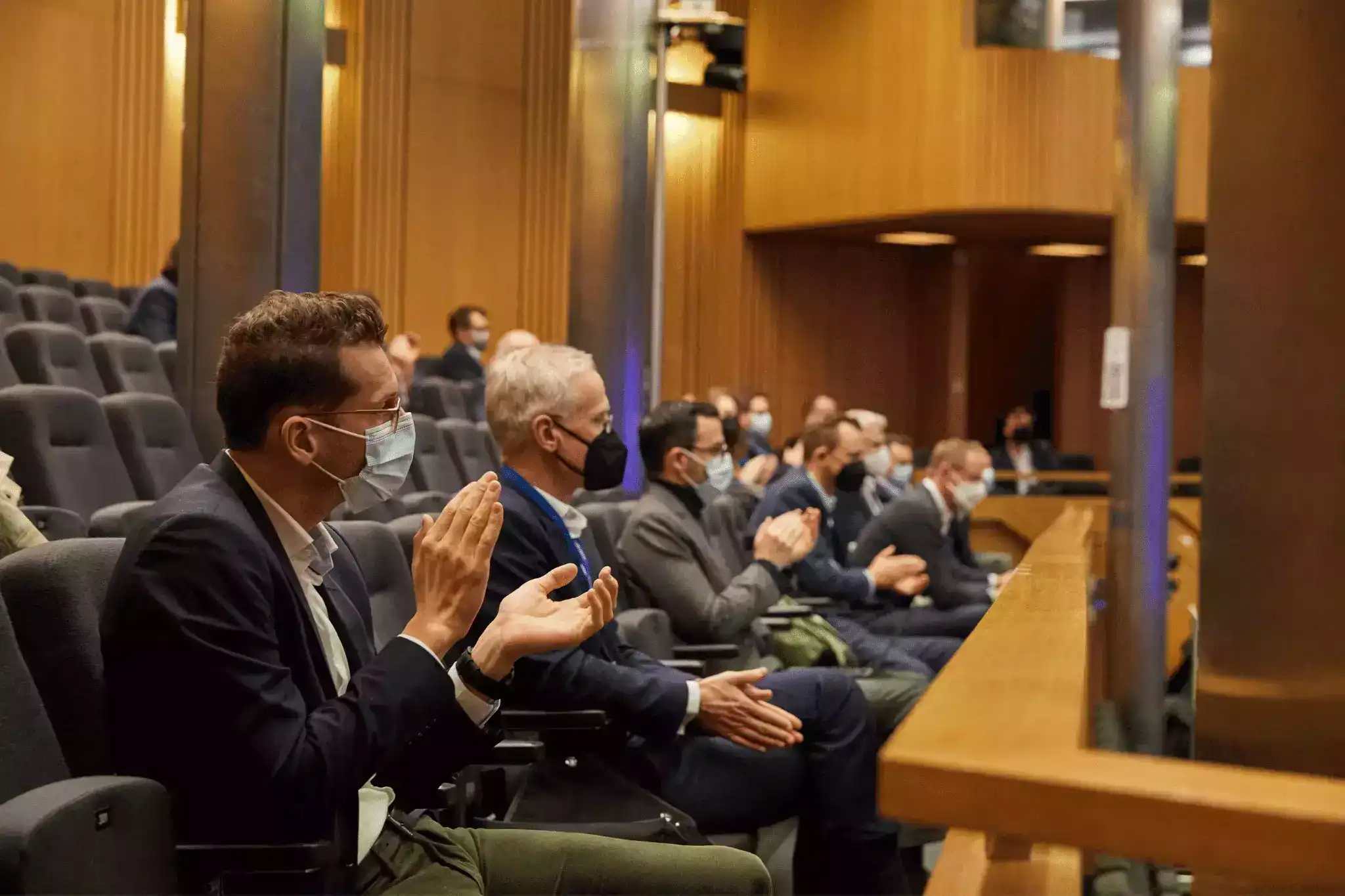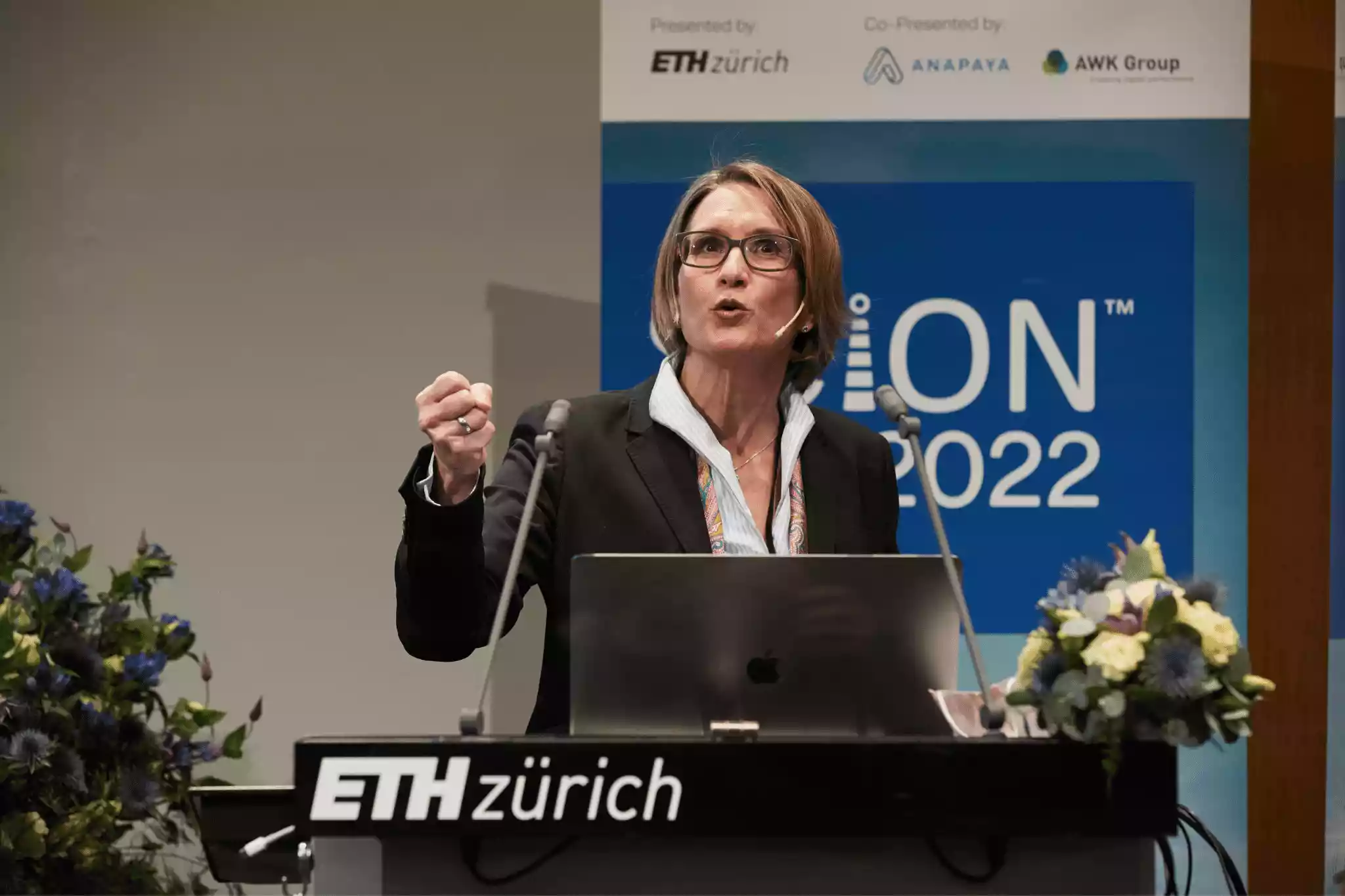SCION Day 2022
On the 26th of January, industry leaders, SCION researchers, and partners came to discuss the advancements and the implementation of SCION. SCION and the SSFN were endorsed by Dr. Andréa Maechler from the SNB, Jos Dijsselhof from SIX, and UBS, as a SCION early adopter as well as industry leaders from across the board. Discover here what they said about SCION, and why SCION is the internet as it should be.
Speakers of the Day
Prof. Adrian Perrig, ETH Zürich
Jos Dijsselhof, CEO, SIX
Dr. Andréa Maechler, Member of the Governing Board, Swiss National Bank (SNB)
Florian Schütz, Federal Cybersecurity Delegate, National Cyber Security Centre
Adrian Anderegg, Partner, AWK Group































Technology & Research
Building the Secure Swiss Finance Network (SSFN) with SCION
Speakers: Fritz Steinmann, Senior Network Security Architect, SIX, William Boye, Head of Network Services, Swiss National Bank (SNB)
Stories from the field - panel discussion
Speakers: Sam Hitz, CTO, Anapaya Systems, Daniel Bertolo, Head of Networks, SWITCH, Eliseo Rodriguez, Head of Connectivity B2B, Sunrise, Stefan Berg, Head of Product Management, Swisscom, Thomas Wacker, Director Core Network Engineering, UBS, Lead: Fritz Steinmann, Sr. Network & Network Security Architect, SIX
Defending the weakest against the strongest, ICRC
Speaker: Vincent Graf Narbel, Strategic Technology Advisor, ICRC
Green Routing
Speaker: Seyedali Tabaeiaghdaei, PhD Student, ETH Zürich
End host bootstrapper
Speaker: Francois Wirz, researcher, ETH Zürich
SBAS, bridging SCION & BGP
Speaker: Prof. Prateek Mittal, Princeton University
DoS attacks in the age of Blockchains
Speaker: Dr. Alberto Sonnino, Research Scientist, Meta Novi (Facebook)
SCION unites multiple providers in
securing data exchanges from
Switzerland to Paris, and all the way to California
Speakers: Sam Hitz, CTO, Anapaya Systems, Daniel Bertolo, Head of Networks, SWITCH, Eliseo Rodriguez, Head of Connectivity B2B, Sunrise, Stefan Berg, Head of Product Management, Swisscom, Thomas Wacker, Director Core Network Engineering, UBS, Lead: Fritz Steinmann, Sr. Network & Network Security Architect, SIX
Business & Industry
The Swiss National Bank (SNB) on SCION adoption
Speaker: Dr. Andréa Maechler, Member of the Governing Board Swiss National Bank
SIX on SCION adoption
Speaker: Jos Dijsselhof, SIX CEO
SCION, Quo Vadis?
Speaker: Prof. Adrian Perrig, ETH Zürich
Strategic relevance of SCION to the Swiss Federal Govt.
Speaker: Florian Schütz, Federal Cybersecurity Delegate, National Cyber Security Center
SCION for European telcos
- international expansion
Speaker: Olaf Swantee, Telecom Executive, former CEO EE, Sunrise
UBS, the early SSFN adopter
Speaker: Thomas Holderegger, Managing Director - Global Head of Security IT, UBS
SCION, strategy and rapid ecosystem expansion
Speaker: Martin Bosshardt, CEO, Anapaya Systems
Enabling business ecosystems with SCION - panel discussion
Speakers: Adrian Anderegg, Partner, AWK Group, Jerome Dilouya, Founder & CEO, InterCloud, Martin Leuthold, Management Board, SWITCH, Markus Nispel, VP International Markets, Extreme Networks, Egon Steinkasserer, CTO, Swisscom B2B, Robert Wigger, Chief Business Officer, Sunrise-UPC, Christopher Koch, Senior Strategy Manager, SIX
SCION Foundation
Speakers: Prof. Vanessa Wood, VP Knowledge Transfer and Corporate Relations, ETH, Patrick Naef, Project Manager SCION Foundation
The SNB on SCION adoption
Speaker: Dr. Andréa Maechler, Member of the Governing Board Swiss National Bank
Why is the SSFN crucial for the Swiss financial sector according to the Swiss National Bank? Dr. Andrea Mächler, a member of the Governing Board for the Swiss National Bank (SNB) and head of information technology, describes the SSFN as crucial for maintaining trust in the financial sector, by making transactions secure, flexible, and reliable. The SSFN allows the Central Bank to ensure that every actor in the financial sector, even the smallest banks, communicate in a secure and economically feasible way. For example, how SCION enables us to pay instantly, as fast as sending a whatsapp message, instead of it taking 2 days. To install such an instant payment system requires incredibly secure cyber infrastructure, which the SSFN can provide.
SIX on SCION adoption
Speaker: Jos Dijsselhof, SIX CEO
What is the potential of the SSFN for communication between Swiss financial institutions? Jos Dijsselhof, CEO of SIX, holds degrees in computer science and business administration and has a long track record of international management in the financial sector. With his passion for technology, he and SIX played a crucial part in implementing the SSFN. He outlines the crucial benefits of SCION for the Swiss financial sector, including its security, resilience, controllability; a system that is clearly governed, but also flexible. As such, the SSFN plays a crucial role in protecting user groups, communication, and payments throughout the Swiss financial sector in a reliable, sustainable, and secure way.
SCION, Quo Vadis?
Speaker: Prof. Adrian Perrig, ETH Zürich, Anapaya
Prof. Adrian Perrig from the Network Security Group at ETH Zürich has developed SCION as the result of a years-long journey that started as an academic research at ETH. Prof. Adrian Perrig illustrates recent milestones in the SCION journey, from its inception to the next generation of secure internet. His talk includes topics such as the advancement in green routing research, improved technologies to drive adoption, and recognition with awards for the SCION team at CoNEXT’21.
Strategic relevance of SCION for Switzerland
Speaker: Florian Schütz, Federal Cybersecurity Delegate, National Cyber Security Center
The world wide web was developed in Switzerland more than 30 years ago. Florian Schütz, the Federal Cybersecurity Delegate from the National Cyber Security Center, explains why we need something new. Outlining why SCION is important at the policy level for Switzerland, he asks, what if, instead of having defense mechanisms in the way of incident response, we actually started building secure systems, such as SCION?
SCION for European telcos - international expansion
Speaker: Olaf Swantee, Telecom Executive, former CEO EE, Sunrise
Why should telecom companies pay attention to SCION? Olaf Swantee, the former CEO EE of Sunrise and a board member of Anapaya, explains why SCION is disruptive for Telcos, and why it brings an entirely new paradigm for businesses. As insightfully outlined in this talk, SCION increases revenue per users for telcos, increasing product differentiation, especially in the B2B market, and takes a stronger position towards government and society to help bring about a more secure internet.
UBS, the Early Adopter
Speaker: Thomas Holderegger, Managing Director - Global Head of Security IT, UBS
Thomas Holderegger is the Global Head of Security IT at UBS and, in a discussion with CEO of Anapaya, Martin Bosshardt, they examine what it means to be an early adopter of SCION technology in the context of the SSFN. They answer the question as to why large financial organizations should innovate when it comes to disruptive internet technology and how they can integrate SCION. Then, they explore how it benefits the implementation of a work-from-home model.
Building SSFN with SCION
Speakers: Fritz Steinmann, Senior Network Security Architect, SIX and William Boye, Head of Network Services, Swiss National Bank (SNB)
SSFN is a freshly built network that protects financial institutions against cyber risks, allows for flexible any-to-any communication between participating financial institutions, and is secure and resilient. William Boye, the Head of Network services at the Swiss National Bank, shares some reflections on setting up the SSFN, and how this addresses some of the current vulnerabilities of the legacy internet for financial institutions. He discusses how to build rules for the use of a safe internet, such as SCION, as a common resource.
Fritz Steinmann, the Senior Network & Network Security Architect at SIX provides insights into how the SSFN ensures smooth and secure payment transactions in the banking services division of SIX.
Panel discussion - stories from the field
Speakers: Sam Hitz, CTO, Anapaya Systems, Daniel Bertolo, Head of Networks, SWITCH, Eliseo Rodriguez, Head of Connectivity B2B, Sunrise, Stefan Berg, Head of Product Management, Swisscom, Thomas Wacker, Director Core Network Engineering, UBS, Fritz Steinmann, Sr. Network & Network Security Architect, SIX
In this panel discussion, a group of industry leaders discuss their experiences with SCION so far, and their vision for SCION’s future applications. Led by Fritz Steinmann, Senior Network & Security Architect at SIX, panelists discussed difficulties in the implementation of SCION, what benefits the implementation of SCION would bring and their vision for SCION technology.
SCION and its rapidly growing ecosystem
Speaker: Martin Bosshardt, CEO, Anapaya Systems
Anapaya believes in a new world without the threats of cyber security and connectivity failures, a world where we can all connect, freely. Martin Bosshard is the CEO of Anapaya, which is at the forefront of implementing SCION as a solution to global developments as well as the home office. Martin introduces our partners and new developments at Anapaya, such as the adoption of SCION by Extreme Networks and Cyberlink.
Panel discussion - enabling business ecosystems with SCION
Speakers: Adrian Anderegg, Partner, AWK Group, Jerome Dilouya, Founder & CEO, InterCloud, Martin Leuthold, Management Board, SWITCH, Markus Nispel, VP International Markets, Extreme Networks, Egon Steinkasserer, CTO, Swisscom B2B, Robert Wigger, Chief Business Officer, Sunrise, Christopher Koch, Senior Strategy Manager, SIX, Fritz Steinmann, Sr. Network & Network Security Architect, SIX
In this panel discussion, a group of experts discusses strategies enterprises of the future can use to communicate within their ecosystems. They discuss this by looking to answer several questions such as: Why are SCION-based networks secure? What are the biggest hurdles to overcome in implementing SCION? How do service providers have to work together to provide companies the opportunity to switch to SCION networks? Why will SCION benefit clients?
Protecting the vulnerable from the most powerful
Speaker: Vincent Graf Narbel, Strategic Technology Advisor, International Committee of the Red Cross (ICRC)
For a neutral humanitarian organization such as the ICRC, trust is fundamental in war-torn areas, but how can the ICRC maintain this trust in the digital age? Vincent Narbel discusses how SCION properties can help and shares a few open questions about operating digital services in humanitarian scenarios.
Green Routing
Speaker: Seyedali Tabaeiaghdaei, PhD Student, ETH Zürich
Given its path-selection features, SCION creates an Internet where end-users can shift traffic - and therefore electricity consumption- to low-emission network operators. Fascinatingly, such environmentally oriented routing creates a reward for providers that invest in energy-efficient equipment and low-emission electricity. ETH PhD student Seyedali Tabaeiaghdaei gives insight into recent research results into this field, obtained in collaboration with PhD Student Simon Scherrer.
Automated bootstrapping
Speaker: Francois Wirz, researcher, ETH Zürich
Enabling millions of devices to seamlessly connect to the SCION network is crucial in order to bring adoption to the next level. Francois Wirz, a software engineer at the network security group for ETH, introduces key mechanisms that allow any device to discover and leverage the available SCION connectivity.
Secure Backbone AS (SBAS)
Speaker: Prof. Prateek Mittal, Princeton University
Prof. Prateek Mittal is an associate professor at Princeton University working on protecting legacy internet communications with a secure backbone of an AS. Some of his key contributions include privacy-enhancing technologies and network security. He discusses how the BGP is vulnerable to routing attacks, and the devastating effects this can have. Because the deployment of SCION is currently limited, Prof Mittal is currently working on offering users of the legacy internet safe access to SCION, which fundamentally eliminates the threat of routing attacks.
Neglected DoS vulnerabilities of blockchain, Consensus Protocol
Speaker: Dr. Alberto Sonnino, Research Scientist, Meta Novi (Facebook)
Dr. Alberto Sonnino is a research Assistant at Meta Novi, focussing on systems security, privacy engineering, and blockchain. As such, he will be outlining how the threat of DoS attacks is underestimated by the blockchain community, and how SCION architecture can help fix this vulnerability.
SCION Foundation
Speakers: Prof. Vanessa Wood, VP Knowledge Transfer and Corporate Relations, ETH and Patrick Naef, Project Manager SCION Foundation
In a joint presentation, Vanessa Wood and Patrick Naef announce the effort to establish the SCION Foundation. The SCION foundation is a non-profit organization facilitating the global adoption of the SCION next-generation Internet to meet the growing requirements for reliability, security, performance, and compliance in the digital economy, fueled by the proliferation of and dependency on interconnected machines, devices and people.
SCION unites multiple providers in securing data exchanges from Switzerland to Paris, and all the way to California
This pre-recorded video outlines how data travels around the world through different SCIONenabled networks, ensuring enhanced security and reliability. Discover how easy it is for network administrators to implement business policies, such as restrictions on the jurisdictions through which the data travels.

